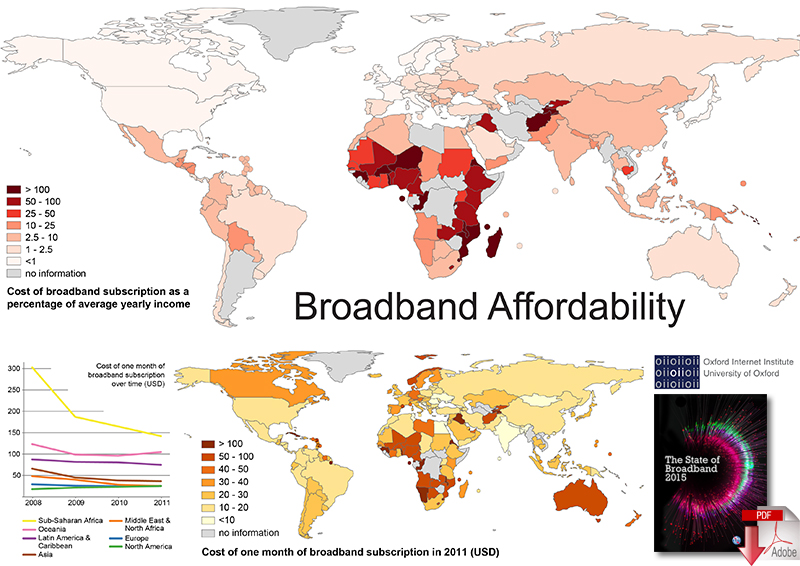Global Broadband Growth Slows Sharply - More Than 4 Billion Still Offline, What?!

UN Broadband Commission releases new country-by-country data on state of broadband access worldwide.
Broadband Internet is failing to reach those who could benefit most, with Internet access reaching near-saturation in the world’s rich nations but not advancing fast enough to benefit the billions of people living in the developing world, according to the 2015 edition of the State of Broadband report.
Released today just ahead of the forthcoming SDG Summit in New York and the parallel meeting of the Broadband Commission for Sustainable Development on September 26, the report reveals that 57% of the world’s people remain offline and unable to take advantage of the enormous economic and social benefits the Internet can offer.
Access to information and communication technologies, particularly broadband Internet, has the potential to serve as a major accelerator of development, with the importance of ICT connectivity specifically recognized in the new UN Sustainable Development Goals.
With the 17 goals now firmly on the global agenda, governments and private industry both have a strong interest in finding ways to get people online, the report argues.
The Broadband Commission comprises more than 50 leaders from across a range of government and industry sectors who are committed to actively assisting countries, UN experts and NGO teams to fully leverage the huge potential of ICTs to drive new national SDG strategies in key areas like education, healthcare and environmental management.
“The UN Sustainable Development Goals remind us that we need to measure global development by the number of those being left behind,” said ITU Secretary-General Houlin Zhao, who serves as co-Vice Chair of the Commission with UNESCO Director-General Irina Bokova.
“The market has done its work connecting the world’s wealthier nations, where a strong business case for network roll-out can easily be made. Our important challenge now is to find ways of getting online the four billion people who still lack the benefits of Internet connectivity, and this will be a primary focus of the Broadband Commission going forward.”
Produced annually by the Broadband Commission, The State of Broadband is a unique global snapshot of broadband network access and affordability, with country-by country data measuring broadband access against key advocacy targets set by the Commission in 2011.
New figures in the report confirm that 3.2 billion people are now connected, up from 2.9 billion last year and equating to 43% of the global population. But while access to the Internet is approaching saturation levels in the developed world, the Net is only accessible to 35% of people in developing countries. The situation in the 48 UN-designated Least Developed Countries is particularly critical, with over 90% of people without any kind of Internet connectivity.
This year’s figures show that the top ten countries for household Internet penetration are all located in Asia or the Middle East. The Republic of Korea continues to have the world’s highest household broadband penetration, with 98.5% of homes connected; Qatar (98%) and Saudi Arabia (94%) are ranked second and third respectively.
Iceland has the highest percentage of individuals using the Internet (98.2%), just ahead of near-neighbours Norway (96.3%) and Denmark (96%).
Monaco remains very slightly ahead of Switzerland as the world leader in fixed broadband penetration, at over 46.8% of the population compared with the Swiss figure of 46%. There are now six economies (Monaco, Switzerland, Denmark, Netherlands, Liechtenstein and France) where fixed broadband penetration exceeds 40%, up from just one (Switzerland) in 2013.
The Asia-Pacific region now accounts for half of all active mobile broadband subscriptions, with Macao, China easily taking top place with 322 active mobile broadband subscriptions per 100 people – or just over 3 subscriptions per inhabitant – followed by second-ranked Singapore (156 subscriptions per 100 people) and Kuwait (140 subscriptions per 100 people).
In total, there are now 79 countries where over 50% of the population is online, up from 77 in 2014. The top ten countries for Internet use are all located in Europe. The lowest levels of Internet access are mostly found in sub-Saharan Africa, with Internet available to less than 2% of the population in Guinea (1.7%), Somalia (1.6%), Burundi (1.4%), Timor Leste (1.1%) and Eritrea (1.0).
“The 2030 Agenda recognizes the power of new technologies to accelerate human progress, to bridge the digital divide, to develop knowledge societies – we must do everything to support States in reaching these goals, especially developing States,” said UNESCO Director-General, Irina Bokova.
“This calls for stronger efforts by governments and all actors, in ensuring access, use and affordability – it requires also greater work to build the capacities of all women and men to make the most of all new opportunities.”
The Commission’s advocacy around the importance of broadband has seen the number of countries with a National Broadband Plan in place grow from 102 in 2010, when the Commission began its work, to 148 today, according to the report.
The State of Broadband 2015 is the fourth edition of the Commission’s broadband connectivity report. Released annually, it is the only report that features country-by-country rankings based on access and affordability for over 160 economies worldwide.
Related: FCC Chairman’s Net Neutrality Plan Turns Broadband into a Public Utility

Article Topics
The Broadband Commission News & Resources
The State of Broadband 2015 Global Broadband Growth Slows Sharply - More Than 4 Billion Still Offline, What?!Latest in Technology
SAP Unveils New AI-Driven Supply Chain Innovations U.S. Manufacturing is Growing but Employment Not Keeping Pace The Two Most Important Factors in Last-Mile Delivery Spotlight Startup: Cart.com is Reimagining Logistics Walmart and Swisslog Expand Partnership with New Texas Facility Taking Stock of Today’s Robotics Market and What the Future Holds Biden Gives Samsung $6.4 Billion For Texas Semiconductor Plants More Technology














